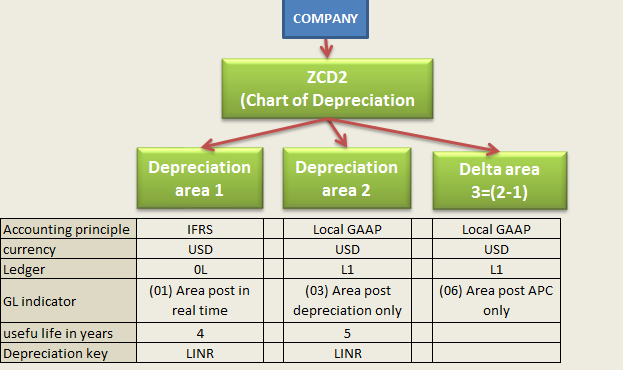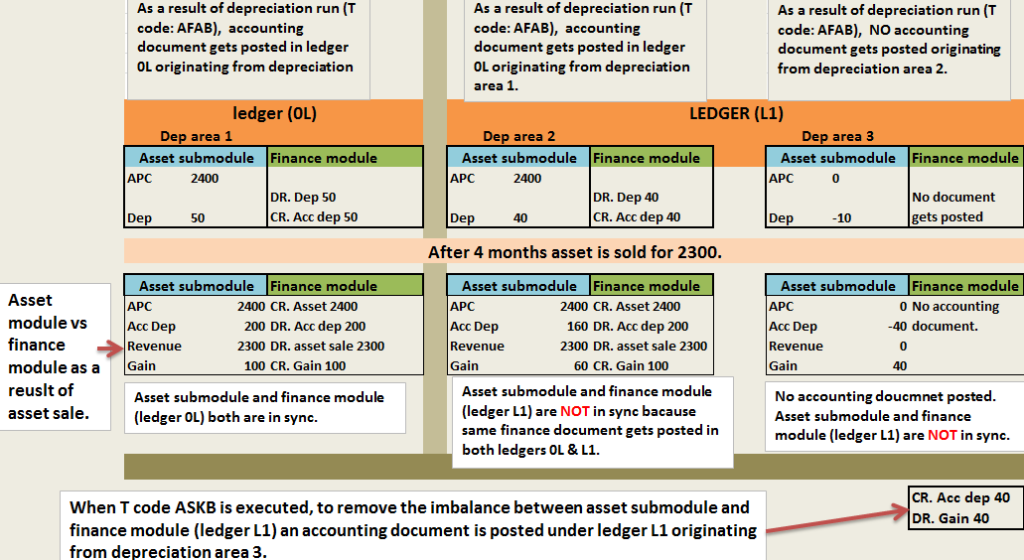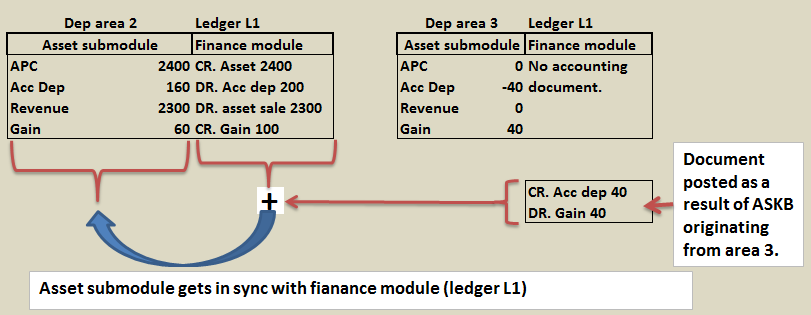Derived depreciation area does not have its own value rather it derives its value from other real depreciation areas.
Below shown the configuration needed for derived depreciation area.
Depreciation area 1 is real depreciation area assigned to ledger 0L.
Depreciation area 2 is real depreciation area assigned to ledger L1.
Depreciation area 3 is derived depreciation area assigned to ledger L1. Since area 3 does not have its own value rather it derives its value from the difference of values between area 2 & area 1 hence no depreciation key is assigned to area 3.

Let’s say asset acquisition value is 2400.
When depreciation run (T code: AFAB) is executed, accounting document for depreciation is posted in area 1 (ledger 0L) and area 2 (ledger L1).
Asset is sold after 4 months for 2300. As a result of asset sale transaction, values will be updated in asset sub-module as well as finance module (accounting document will be posted in corresponding ledgers).

Consider depreciation area 1.
Accumulated depreciation in 4 months is 200.
Net book value of asset was= 2400-200=2200
But asset is sold for 2300 hence gain on sale of asset is 100.
Asset sub-module and finance module (ledger 0L) both are in sync.
Consider depreciation area 2.
Accumulated depreciation in 4 months is 160.
Net book value of asset was= 2400-160=2240
Asset is sold for 2300 hence gain on sale of asset is 60.
But same accounting document which is posted in ledger 0L gets posted in ledger L1 also. Hence asset sub-module and finance module (ledger L1) are not is sync.
Consider depreciation area 3
No accounting document is posted as of now.
Now period asset posting (T code: ASKB) is executed. As a result, below accounting document gets posted in ledger L1 originating from area 3.


As a result of document originating from derived depreciation area 3, asset module and finance module (ledger L1) comes in sync.
Summary:
Derived depreciation area derives its value from difference between two real depreciation areas.
No depreciation key is assigned to derived area.
GL indicator of derived depreciation area is 06 (area post APC only).
When periodic asset posting (T code ASKB) is executed at month end then accounting document is posted in corresponding ledger to remove imbalance between asset sub-module and finance module.
GL ACCOUNTING
- What is SAP FICO ?What business requirement is fulfilled in this module?
- What is enterprise structure in sap fico?
- What is GL account? What is account group? What is operational chart of accounts?
- What is the need of country chart of account or alternate chart of account? How country chart of account helps fulfill a business requirement?
- What is the need for group chart of account? How group chart of account helps in consolidation of financial data?
- What is non leading ledger in sap fico?
- What is company code global settings? What global parameter is assigned to company code?
- What is fiscal year variant? Why fiscal year variant is assigned to company code?
- What is posting period variant? Why posting period variant is assigned to company code?
- What is field status variant? What is field status group?
- What is document type in sap? Explain the purpose of document type?
- Document date vs Posting date vs Entry date vs Translation date. Explain
- What is posting key? what is the use of posting key?
- Document header & line items capture information of business transaction.
- Everything about currency & exchange rate in sap.
- Foreign currency valuation in sap. Explain with example
- Retained earnings account helps in year end balance carry forward. Explain
- What is the significance of tolerance groups in sap?
- What parameters are maintained in GL master and how does it impact in document posting?
ACCOUNTS PAYABLE
- What is meant by accounts payable in sap?
- Understanding procure to pay (PTP) cycle and accounting document at each step.
- Understanding MM FI integration in very simple terms.
- Purchase order price determination in SAP. Explained in very simple words.
- House bank, Bank key, Account ID in SAP
- What configuration (FBZP) needed for executing F110 in sap ?
ACCOUNTS RECEIVABLE
- How sap overcomes challenges in accounts receivable process?
- What is customer reconciliation account?
- Understanding order to cash cycle in sap.
- Understanding SD FI integration in very simple terms.
- What is lock box? How lockbox helps in collection from customers?
TAX ACCOUNTING
- How sap helps in tax accounting?
- Tax configuration in sap: Tax procedure, Tax code & Tax jurisdiction code
- Concept of tax jurisdiction code & tax jurisdiction structure
- Significance of “Tax category & Posting without tax allowed” in GL master.
- Tax base amount and Discount base amount
- Assigning tax code V0 & A0 for non taxable transaction?
- Deductible input tax vs non deductible input tax
WITHHOLDING TAX
- Withholding tax in sap explained with example.
- How sap overcomes challenges in managing withholding tax?
- Withholding at the time of invoice or payment
- Withholding tax configuration in sap
- Business place & Section code in sap
- Withholding tax certificate numbering in sap
- Withholding tax report for filling tax returns
ASSET ACCOUNTING
- How sap helps in asset accounting?
- What is meant by asset accounting?
- What is the use of asset class?
- What is the use of depreciation key in asset accounting?
- Depreciation area and Chart of depreciation in sap.
- Derived depreciation area VS real depreciation area?
- Understanding asset accounting configuration needed in sap
- GL account determination for posting asset transaction
- Asset transaction and corresponding accounting document?
- How depreciation is posted in sap?
SAP CONTROLLING